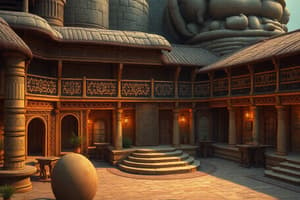Podcast
Questions and Answers
What is one of the primary characteristics of a civilization as outlined by V.Gordon Childe and revised by Charles Redman?
What is one of the primary characteristics of a civilization as outlined by V.Gordon Childe and revised by Charles Redman?
- Full-time labor specialization (correct)
- Standardized artwork
- Long distance trade
- Writing/record keeping
Which region is identified as the earliest place where civilization emerged?
Which region is identified as the earliest place where civilization emerged?
- Northern Mesopotamia
- Western Europe
- Southern Mesopotamia (correct)
- Eastern Asia
What is NOT a characteristic of a civilization based on the outline provided?
What is NOT a characteristic of a civilization based on the outline provided?
- Concentration of surplus
- Nomadic lifestyle (correct)
- Class stratification with ruling stratum
- Cities
What type of soils in Southern Mesopotamia provide exceptional growing conditions for surplus production?
What type of soils in Southern Mesopotamia provide exceptional growing conditions for surplus production?
Which of the following is considered a secondary characteristic of a civilization according to the text?
Which of the following is considered a secondary characteristic of a civilization according to the text?
What type of growth was seen in the site of Uruk during the period mentioned?
What type of growth was seen in the site of Uruk during the period mentioned?
What was the dominant feature of the redistribution system in Uruk during the specified time period?
What was the dominant feature of the redistribution system in Uruk during the specified time period?
What served as early accounting devices before the evolution of the cuneiform writing system?
What served as early accounting devices before the evolution of the cuneiform writing system?
Who deciphered how the cuneiform writing system developed?
Who deciphered how the cuneiform writing system developed?
What major event led to the deciphering of the Rosetta Stone in 1799?
What major event led to the deciphering of the Rosetta Stone in 1799?
In which year did Jean-François Champollion publish a work on deciphering hieroglyphs?
In which year did Jean-François Champollion publish a work on deciphering hieroglyphs?
What were the two fundamental resources that facilitated the rise of complex societies in Southern Mesopotamia?
What were the two fundamental resources that facilitated the rise of complex societies in Southern Mesopotamia?
During the Ubaid period, what emerged as the basic unit of social organization?
During the Ubaid period, what emerged as the basic unit of social organization?
What characterized the social complexity during the Ubaid period in Mesopotamia?
What characterized the social complexity during the Ubaid period in Mesopotamia?
Which type of economy dominated wealth concentration, redistribution, and rationing of staples and goods during the Ubaid period?
Which type of economy dominated wealth concentration, redistribution, and rationing of staples and goods during the Ubaid period?
What facilitated more systematic long-distance exchange during the Ubaid period?
What facilitated more systematic long-distance exchange during the Ubaid period?
What was a key feature of the growth of Temple Power in Eridu during the Ubaid period?
What was a key feature of the growth of Temple Power in Eridu during the Ubaid period?
Which symbolic representation on the Narmer palette signifies the unification of Upper and Lower Egypt?
Which symbolic representation on the Narmer palette signifies the unification of Upper and Lower Egypt?
What role did the Nile River play in southern Mesopotamia and Egypt?
What role did the Nile River play in southern Mesopotamia and Egypt?
What does the term 'Cartouche' refer to in Egyptian inscriptions?
What does the term 'Cartouche' refer to in Egyptian inscriptions?
What was one of the main benefits of the summer flooding of the Blue Nile?
What was one of the main benefits of the summer flooding of the Blue Nile?
Which god is depicted on Side 2 of Narmer's palette, associated with agriculture?
Which god is depicted on Side 2 of Narmer's palette, associated with agriculture?
In what capacity did King Narmer serve after uniting Upper and Lower Egypt?
In what capacity did King Narmer serve after uniting Upper and Lower Egypt?
Who built the first pyramid at Saqqarah?
Who built the first pyramid at Saqqarah?
During which Dynasty were the pyramids at Giza built?
During which Dynasty were the pyramids at Giza built?
What is the significance of Tutankhamun in archaeology?
What is the significance of Tutankhamun in archaeology?
What was the significance of the scarab located in Tutankhamun's tomb?
What was the significance of the scarab located in Tutankhamun's tomb?
What sparked the 'Curse of the Mummy' idea related to Tutankhamun's discovery?
What sparked the 'Curse of the Mummy' idea related to Tutankhamun's discovery?
What recent findings suggest regarding Tutankhamun's death?
What recent findings suggest regarding Tutankhamun's death?
Flashcards are hidden until you start studying



